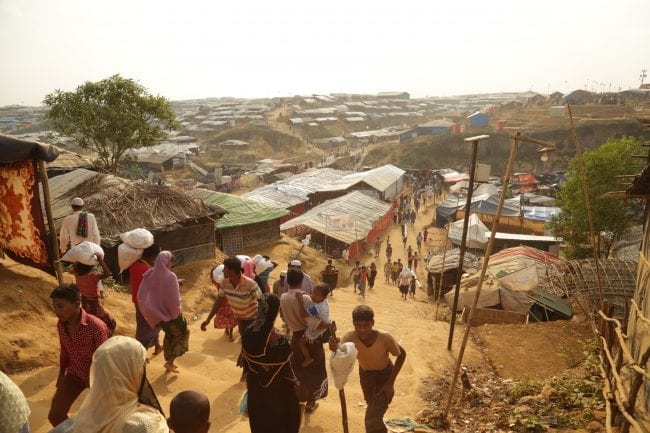
Human Trafficking and the Rohingya Refugee Crisis
Since August 2017 over 650,000 Rohingya have fled their homes in Myanmar to seek safety in neighboring Bangladesh. Driven from their communities by Myanmar’s armed forces – who have burned villages, raped, and killed infants after ripping them from their mother’s arms – most of the refugees have settled in camps in the Bangladeshi city of Cox’s Bazar. The overcrowded living conditions present many challenges and risks, including human trafficking.
The Rohingya are a majority Muslim ethnic group that reside – prior to their expulsion – primarily in Myanmar. They are effectively stateless, unable to receive citizenship in their home country and unwanted in Bangladesh. In addition to being a fundamental abuse of human rights and dignity, this lack of citizenship reduces economic opportunity, increases isolation, limits mobility and opportunities for family reunification, and heightens the risk of human trafficking. Reports suggest that trafficking is rampant in the refugee camps with men, women, and children exploited for commercial sex and forced and bonded labor. The risk of trafficking is even higher for children, particularly those without parents.
World Vision, Save the Children, and Plan International recently published a report, “Childhood Interrupted: Children’s Voices from the Rohingya Refugee Crisis,” which documents the lives of children in the refugee camps of Cox’s Bazar and highlights the fears they experience on a daily basis, including human trafficking. Though data on human trafficking of Rohingya refugees is scarce, the risk appears to be on the minds of children and adults alike. And while trafficking networks have recruited from Rohingya refugee camps for years, reports depict a substantial increase since the current influx of refugees began in August 2017. Kidnapping is a common tactic of traffickers in the camps. In “Childhood Interrupted,” children discuss traveling in groups to reduce risk, avoiding the bathrooms at night and their fear of being kidnapped from their tents at night.
Traffickers also lure men, women, and children with false job offers in fishing, begging, and, for girls specifically, domestic work. Once an offer is accepted, individuals are often trapped, abused, and not paid the agreed amount, if at all. Physical and sexual abuse is common for women and girls, who are frequently forced into prostitution after accepting jobs as domestic workers. Traffickers prey on the vulnerability of families who are struggling to put food on the table and children that have traveled alone after losing their parents. They will often pay these struggling families for their daughters with the promise of work, though many of the girls are never seen again. While much of the trafficking occurs within Bangladesh, the International Organization of Migration reports that there is evidence of trafficking of Rohingya refugees in India and other regional countries.
The chaos, poverty, and insecurity in the camps has also led to an increase in forced and child marriage as families can view marriage as an opportunity to protect their daughters and reduce their economic overhead. Families are also selling their children into bonded labor, particularly in fish drying. To combat this practice and encourage families to keep children in school, UNICEF has provided 400 families with the same amount of money they would receive from selling a child into bonded labor. Rohingya living in the camps have also made efforts to prevent trafficking and reunite lost or missing children with their families. In fall 2017, the Thomson Reuters Foundation visited the Kutupalong refugee camp and detailed the work of Nazir Ahmed who set up an information center to connect parents with their missing children. He watches the children and, to ensure they are not taken by traffickers, requires the adults that come for them to recite their full name and the child’s confirmation that the adult is their parent.
The stories we’ve heard of human trafficking of Rohingya refugees are, for sure, only a portion of the full trafficking landscape. In the ongoing chaos of the continually expanding camps, human trafficking lacks a reporting mechanism and can go unnoticed and/or unaddressed. Indeed, the current Rohingya refugee crisis is just the latest example of how human trafficking is intertwined in humanitarian settings. As is the case in Libya, Syria, migration routes through the Balkans, and elsewhere, the risk of human trafficking increases during migration crises. As global migration continues to increase, both by force and choice, networks and institutions should be strengthened to combat human trafficking and modern-day slavery. Addressing the added vulnerability of statelessness is a good place to start.
Liza Kane-Hartnett is the Director of Communications for Human Trafficking Search.
Photo courtesy of DFID.
